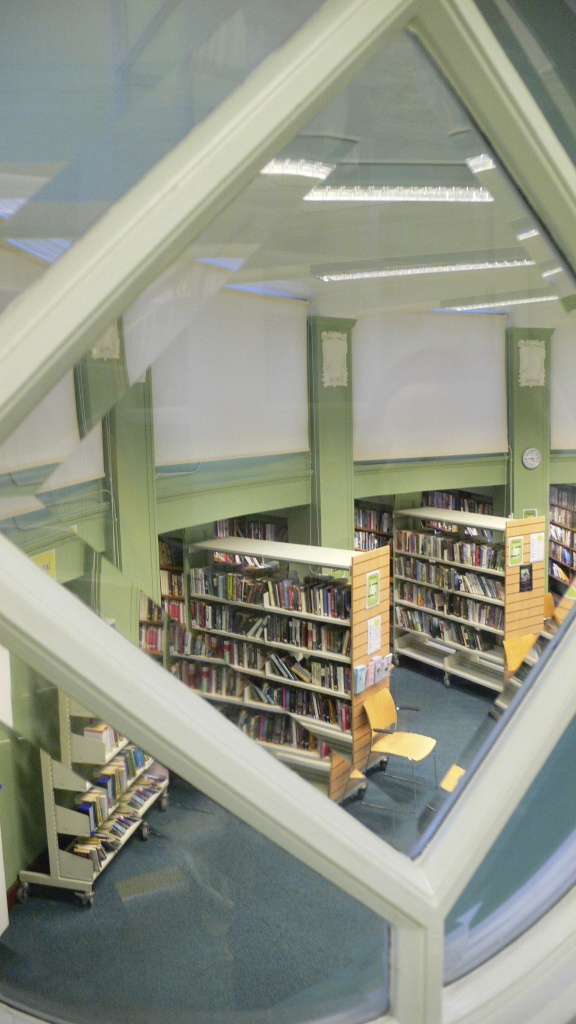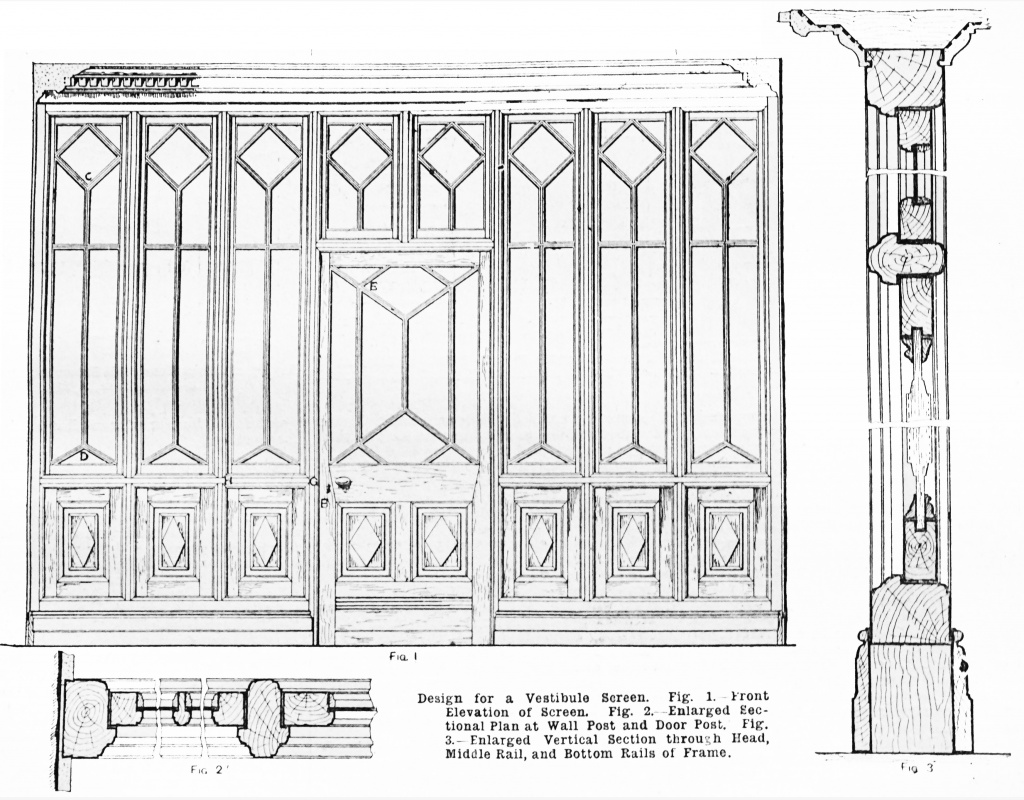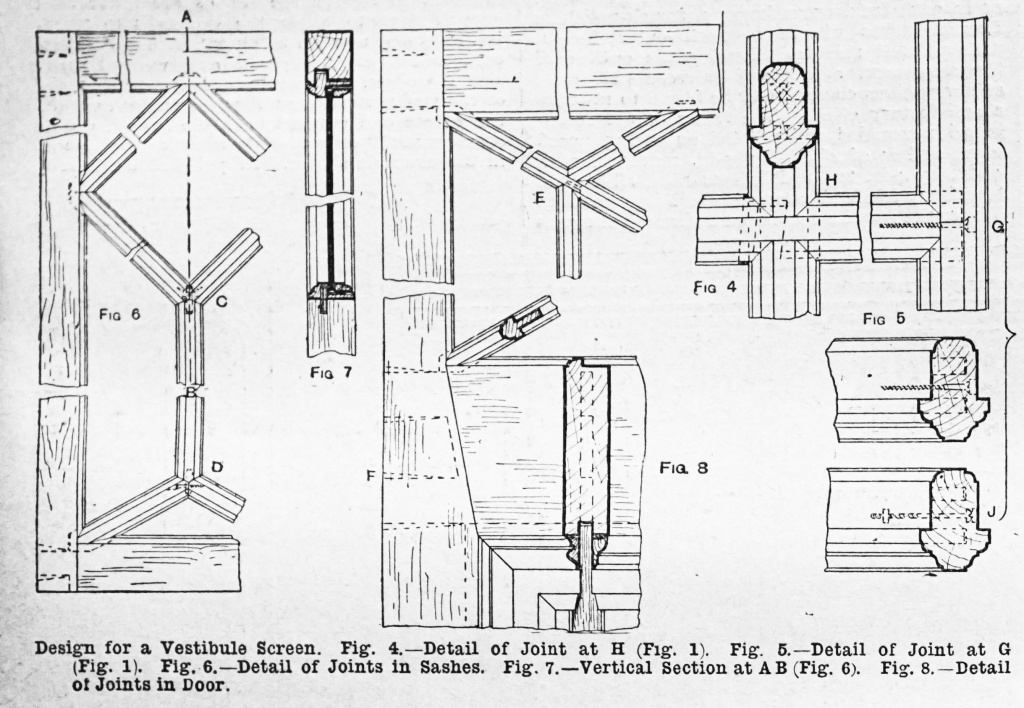Transparent walls

Glazed partitions and internal windows were frequently used to separate areas of the libraries whilst maintaining the potential for the librarians to have adequate surveillance. They also enabled the “borrowing” of light from one space to another.
As buildings have been adapted and modernised over the years, many of these screens have been removed. Nevertheless we have recorded 138 buildings where they are still evident.
Article transcribed from: RICHARDSON, W. (1895). Building world. London, Printed and published by Cassell & Company Limited. No. 585 – December 29, 1906. P. 203-4
DESIGN FOR A VESTIBULE SCREEN.
FIGS. 1 to 8 Show in design and detail a vestibule screen for the Hall of a large residence or a public building. the height of the screen is 9ft. 6 in. to the cornice ; the width, 13 ft. ; But the design can be applied at pleasure to narrower halls, or corridors, either by emitting panels or by slightly increasing or diminishing their widths. (For Figs. 4 to 8, see next page.)

To obtain good design, the panels over the door must be of similar width to the side panels ; that is to say, the widths of all the panels shall be such as to give a convenient and proportionate doorway. For public buildings it may be necessary to have a doorway so wide as to require a pair of swing or folding doors, instead of the single door here shown. in that case the widths of the panel would have to be altered to suit the width of the doors. another point that has been carefully observed in the general arrangement is that of carrying all principle horizontal lines across the entire width of the screen. For instance, the edges off the bottom rails of the sashes and the lock rail of the door, are in one line, and the wide bottom rail of the door is broken by sunk mouldings, carried through at the same level as the edges of the plinth and Bottom rail of the frame. Inattention to this point of detail in designs of this class usually results in a broken outline, and a consequent loss of character in the design.
The design is shown suitable for construction in yellow pine (to be finished in white enamel), or in oak, teak, or mahogany, french-polished. Leaded Lights of simple rectangular design, with parallel margins following the outline of the sash bars, and glazed in very pale tints of harmonious colours, will be found to produce a satisfactory effect. The frame of the screen is twice moulded and rebated on each exposed edge, and is of 41/2-in. by 3-in. material, with 41/2-in. by 4-in. Top and bottom rails, all framed together with double tenons (see Figs. 4 and 5). Where unseen the tenons pass through the rails or stiles, And are glued or double wedged in the usual manner. Joints in the frame, as at G and H (Fig. 1), are formed as shown in detail in Figs. 4 and 5. In Fig. 5, the tenons Us stopped short, glued, and screwed through the stile, the sinking for the screw head being bored with the centrebit and pelleted up after drawing up the joint. Round Steel nails are often used for the same purpose, and are sunk below the surface in the same way. Screwing into end grain is not considered good in general practice, but with a screw of good length and diameter the joint shown can be easily drawn tight. An alternative and a superior method is shown in sectional plan at J (Fig. 5), wear a parallel set screw, with a roundhead and square nut, is used, the not being housed into the rail from the upper edge, and the screw turned into it through the stile.

Fig. 4. Shows the middle of the rail of the frame, with muntins entering above and below. Dove-tail tenons are used (see dotted lines). The mortices to receive the tenons are made long enough just to allow the dovetails to enter, the extended mortice being cut with a bevelled end and the joint glued and wedged with single wedges. A portion of the end grain of the wedge is visible unless it is placed within the rebate and covered with the sashes, which arrangement is only possible with the back tenon in the example shown. In polished hardwood, end grain like this is ought not to show, and the wedging would have to be omitted, unless the tenons could be placed entirely within the rebate. In such cases, the bottom and middle rail and the intervening muntins are glued and cramped together in the workshop, and the upper muntins are glued and forced home by wedging them down tight from the ceiling above. In all cases the joints throughout are fitted together, and the faces levelled and finished, in the workshop, although the whole frame may be too large to put together there permanently.
The sashes for the top panels are 2 in. thick, with 2 in. wide stiles, 21/2-in. Top and bottom rails, and 1-in. bar filling; the moulds being stuck 5/16-in. deep. The Joints are mortised and tenoned together wherever possible (see Figs. 6,7 and 8); the thickness of the tenons being exactly equal to, and placed on, the square edges of the sash members.
At C and D (Fig. 6) tenons cannot be conveniently used, and the method adopted is to mitre the three members together and glue and screw, or brad (see Fig. 6) the two inclined bars together, through the back part of the bar and then dowel the vertical bar into the thick portion of the joint, by 5/16-in. dowels (see Figs. 6 and 7). The Jointing of the bars of the door will be quite clear from Fig. 8.
The panelled frames filling in the bottom part of the screen are 2 in. thick by 3 in. wide on face, with 11/2-in. raised panels, having 1/4-in. raised diamond centres, with flat faces. In Fig. 3 their projection is shown by the dotted line. Several designs of planting mould are shown in the details.
When these frames and sashes are completed, and the frame has been made ready for them, they are all perfectly fitted into their respective rebates from behind. The sashes are fixed by screws through the rebates, and the panelled frames by screw brads; or, if they are in hardwood, by secret nailing or gluing only.
A plinth of the same pattern as that which is used round the Hall is carried across the face of the screen and fixed to the stiles, to the bottom rail and to the upright packings under each muntin provided. In polished work, the secret screwing would be employed. the ends of the plinth against the doorway are returned in the solid to the face of the doorpost. A plaster cornice is carried across both faces of the screen, on rough brackets. Part of one of these is shown in Fig. 3.
The let it lights are secured by glazing screeds moulded similarly to the face mould of the sashes. the door is hung with three 4-in. cast brass butt hinges, and the doorposts require housing into the floor to make them perfectly rigid.
F.E. DRURY. (d.29.11.1950)
List of open Carnegie libraries with glazed partitions identified in this project:
| Dundee – Arthurstone Community Library | William Alexander (City Architect) & James Thomson | 1905 | 5 Arthurstone Terrace | DD4 6RT |
| Ewart Library (Dumfries) | Alan B. Crombie | 1904 | Catherine St Dumfries | DG1 1JB |
| West Calder Library | William Baillie | 1904 | 24-26 Main St | EH55 8DR |
| Ayr Carnegie Library | Campbell Douglas & Morrison | 1893 | 12 Main Street | KA8 8EB |
| Dartford Central Library & Museum | Thomas Edward Tiffin (Town Surveyor) | 1916 | Market St | DA1 1EU |
| Burnley Library | George Hartley and Arthur Race (Borough Engineer) | 1930 | 19-29 Parker Ln | BB11 2BD |
| Accrington Carnegie Public Library | William J. Newton (Borough Engineer) | 1908 | St James’ St | BB5 1NQ |
| Liverpool – Toxteth Library (Soth-end) | Thomas Shelmerdine (Corporation Architect and Surveyor) | 1902 | Windsor St, Liverpool | L8 1XF |
| Milnrow Library | S. Butterworth & W.H. Duncan | 1908 | 57 Newhey Rd | OL16 3NP |
| Sandwell – West Bromwich Central Library | Stephen James Holliday | 1907 | 316 High St | B70 8DZ |
| Sandwell – Wednesbury Library | Crouch Butler and Savage | 1908 | Walsall St | WS10 9EH |
| Arthur Ernest McKewan & James Arthur Swan | 1904 | North Street | BD21 3SH | |
| Leeds – Morley Library | W.E. Putman (Borough Engineer) | 1906 | Commercial St, | LS27 8HZ |
| Cardiff – Cathays Library | Speir & Bevan | 1907 | Fairoak Road | CF24 4PW |
| Wallasey (Liscard) Central Library | R.B. MacColl & George Edward Tonge | 1911 | 17 Earlston Rd | CH45 5DX |
| Manchester – Failsworth Library | Ernest Ogden & Percy Cartwright Hoy | 1909 | 397 Oldham Rd | M35 0AE |
| Royton Library | S. Butterworth & W.H. Duncan | 1907 | Rochdale Rd | OL2 6QJ |
| Clackmannan | Ebenezer Simpson | 1903 | Main Street | FK10 4JA |
| Wombwell Library | Arthur B. Linford | 1907 | Station Rd | S73 0BA |
| Belfast – Falls Road Library | Watt and Tullock | 1908 | 49 Falls Rd | BT12 4PD |
| Lurgan Library | Henry William Edward Hobart | 1906 | 1 Carnegie Street | BT66 6AS |
| Dundee – Coldside Library | James Thomson & Frank Drummon Thomson | 1908 | 150 Strathmartine Rd | DD3 7SE |
| Arbroath Academy and Public Library | James Black | 1898 | Hill Terrace | DD11 1AH |
| Dundee – Blackness Library | James Thomson & Frank Drummon Thomson | 1908 | 225 Perth Rd | DD2 1EJ |
| Falkirk Community Trust Library | Sir George Washington Browne | 1902 | Hope St | FK1 5AU |
| Stirling | Henry ‘Harry’ Ramsay Taylor | 1904 | Corn Exchange Road | FK8 2HX |
| Glasgow – Maryhill Library | James Robert Rhind | 1905 | 1501 Maryhill Rd | G20 9AD |
| Glasgow – Possilpark Library | George Simpson | 1913 | 127 Allander St | G22 5JJ |
| Glasgow – Woodside District Library | James Robert Rhind | 1905 | 343 St George’s Rd | G3 6JQ |
| Glasgow – Parkhead Library | James Robert Rhind | 1906 | 64 Tollcross Rd | G31 4XA |
| Glasgow – Langside Library | George Simpson | 1915 | Sinclair Drive | G42 9QE |
| Rutherglen | George Sinclair and John Ballantine | 1907 | Main Street | G73 2HB |
| Clydebank Library | Alexander McInnes Gardner & Robert Whyte | 1913 | Dumbarton Rd | G81 1XH |
| Burntisland Library | William Williamson (City Architect) | 1907 | 102 High St | KY3 9AS |
| Hamilton | Alex Cullen, Lochhead & Brown | 1914 | 102 Cadzow Street | ML3 6HH |
| Kelso Library | John More Dick Peddie & Sir George Washington Browne | 1906 | Bowmont Street | TD5 7JH |
| Jedburgh Library | John More Dick Peddie & Sir George Washington Browne | 1900 | Castlegate | TD8 6AS |
| Hawick Library | J. Nicholl Scott and Alexander Lorne Campbell | 1904 | North Bridge Street | TD9 9QT |
| Aberdeen Central Library | Alexander Brown and George Watt | 1892 | Rosemount Viaduct | AB25 1GW |
| Glasgow – Partick Library | Office of Public Works | 1926 | 305 Dumbarton Rd, Glasgow | G11 6AB |
| Cromarty Library (Hugh Miller Institute) | Alexander Ross & Robert John Macbeth | 1904 | 51 Church St | IV11 8XA |
| Ilkeston Library | Hunter and Woodhouse | 1904 | Market Street | DE7 5RN |
| Leicester Central Library | Edward Burgess | 1905 | Bishop Street | LE1 6AA |
| Loughborough Library | Barrowcliff & Allcock | 1905 | Granby St | LE11 3DZ |
| Lincoln Central Library | Sir Reginald Theodore Blomfield | 1914 | Free School Ln | LN2 1EZ |
| Long Eaton Library | Child, Gorman and Ross | 1906 | Tamworth Rd | NG10 1JG |
| King’s Lynn Library | Herbert John Green | 1905 | London Rd | PE30 5EZ |
| Mile End Central Library (Tower Hamlets Local History Library and Archives) Stepney | James Knight originally 1862, Extension by MW Jameson, Borough Surveyor | 1906 | 277 Bancroft Rd | E1 4DQ |
| Lea Bridge Library | William Jacques | 1906 | Lea Bridge Road | E10 7HU |
| Cubitt Town Library | Charles Harold Norton | 1905 | 52 Strattondale St | E14 3HG |
| Bethnal Green Library | James Tolley | 1922 | Cambridge Heath Rd | E2 0HL |
| Cheshunt Library | J. Myrtle Smith | 1907 | Turners Hill | EN8 8LB |
| Islington West Library | Arthur Beresford Pite | 1907 | 107 Bridgeman Rd | N1 1BD |
| Islington South Library | Sir Mervyn Edwin Macartney | 1921 | 115-117 Essex Rd, | N1 2SL |
| Stoke Newington Library | H.H. Bridgman & Goss (originally 1892) | 1904 | 184 Stoke Newington Church | N16 0JS |
| Highgate Library (Hampstead) | William Nisbet Blair (Borough Engineer) | 1906 | Chester Road | N19 5DH |
| Islington North Library | Henry Thomas Hare | 1906 | Manor Gardens | N7 6JX |
| West Greenwich Library | Herbert Winkler Wills and John Anderson | 1907 | High Road | SE10 8NN |
| Plumstead Public Library | Frank Sumner (Borough Surveyor) | 1904 | High Street | SE18 1JL |
| Lambeth Herne Hill Carnegie Library | H. Wakeford & Sons | 1906 | Herne Hill Road | SE24 0AG |
| Torridon Library (Hither Green – Corbett Community Library) | Henry Hopton | 1907 | Torridon Rd | SE6 1RQ |
| Eltham Central Library (Woolwich) | Maurice Bingham Adams | 1906 | Archery Road | SE9 1HA |
| Twickenham Library | Howard Goadby | 1907 | Garfield Rd | TW1 3JT |
| Teddington Library | Henry Arthur Cheers | 1906 | Waldegrave Rd | TW11 8NY |
| Hammersmith Library | Henry Thomas Hare | 1905 | Shepherds Bush Road | W6 7AT |
| Annfield Plain Library | Edward Cratney | 1908 | North Rd | DH9 8EZ |
| Middlesbrough Central Library | Sir Thomas Edwin Cooper | 1912 | Centre Square, Middlesbrough | TS1 2AY |
| Rawtenstall Library | Crouch Butler & Savage | 1906 | Haslingden Rd | BB4 6QU |
| Bolton – Farnworth Library | W.J. Lomax | 1911 | Market St | BL4 7PG |
| Cleator Moor Library | E.M. Martindale | 1906 | Market St | CA25 5AP |
| Blackpool Central Library | Alex Cullen, Lochhead & Brown | 1911 | Queen St | FY1 1PX |
| Barrow in Furness Library | Alderman John Charles | 1922 | Ramsden Square | LA14 1LL |
| Kendal library | T.F. Pennington | 1909 | Stricklandgate | LA9 4PY |
| Manchester – Didsbury Library | Henry Price (City Architect) | 1915 | 692 Wilmslow Rd | M20 2DN |
| Eccles Gateway | Edward Potts (Potts Son & Hennings) | 1907 | 28 Barton Ln | M30 0TU |
| Heywood Library | North & Robin | 1906 | Lance Corporal Stephen Shaw M C Way | OL10 1LL |
| Ashton in Makerfield Library | J. B. & W. Thornley | 1906 | Wigan Rd | WN4 9BH |
| Folkestone Library | Brightwen Binyon | 1910 | 2 Grace Hill | CT20 1HD |
| Fratton Carnegie Library (Portsmouth) | George Rake & Arthur Edward Cogswell | 1906 | Fratton Rd | PO1 5EZ |
| Caversham Free Public Library (one of 2 branches for Reading) | W.G. Lewton | 1907 | Church St | RG4 8AU |
| Bideford Library and Museum | A.J. Dunn | 1906 | New Road | EX39 2HR |
| Bridgwater Library | Ernest Godfrey Page | 1906 | Binford Pl | TA6 3LF |
| Merthyr Tydfil – Treharris Library | William Dowdeswell | 1909 | Perrott Street | CF46 5ET |
| Merthyr Tydfil Central Library | Johnson Richards and Rees | 1936 | High Street | CF47 8AF |
| Merthyr Tydfil – Dowlais Library | E. A. Johnson | 1907 | Church Street | CF48 3HS |
| Cardiff – Canton Library | Edwin Montgomery Bruce Vaughan | 1907 | Library Street | CF5 1QD |
| Penarth Library | Harry Snell | 1905 | Stanwell Road | CF64 2YT |
| Llandudno Library | George Alfred Humphreys | 1910 | Mostyn Street | LL30 2RP |
| Pontypool Library | Speir & Bevan | 1908 | Hanbury Road | NP4 6JL |
| Abergavenny Library | B.J. Francis | 1906 | Baker Street | NP7 5BD |
| Taibach Port Talbot Margam Community Library | John Cox (District Surveyor) | 1916 | 5 Commercial Rd | SA13 1LN |
| Birmingham – Kings Heath (Moseley) Library | Arthur Gilbey Latham | 1906 | 2 High St | B14 7SW |
| Birmingham – Erdington Library | John P. Osborne | 1907 | Orphanage Rd | B24 9HP |
| Birmingham – Stirchley Library | John P. Osborne | 1907 | Bournville Lane | B30 2JT |
| Sandwell – Cradley Heath Library (Rowley Regis) | Herbert Winkler Wills and John Anderson | 1909 | Upper High St | B64 5JU |
| Sandwell – Dudley Library | George H. Wenyon | 1909 | St James’s Rd | DY1 1HR |
| Northamptonshire Central Library | Herbert Norman | 1910 | Abington Street | NN1 2BA |
| Kettering Library | J. Goddard, A.H. Paget & W.A. Catlow | 1904 | Sheep Street | NN16 0AY |
| Malvern Library | Henry Arthur Crouch | 1906 | Graham Rd | WR14 2HU |
| Gainsborough Library | H.G. Gamble | 1905 | Cobden Street | DN21 2NG |
| Ilkley Library | William Bakewell | 1907 | Station Rd | LS29 8HA |
| Walkley Library | William Frederick Hemsoll & Henry Leslie Paterson | 1905 | 403 South Rd | S6 3TD |
| Batley Library | Walter Hanstock & Son | 1907 | 14 Market P | WF17 5DA |
| York Central Library | Brierley and Rutherford | 1927 | Library Square, Museum Street | YO1 7DS |
| Walthamstow Central Library | J.Williams Dunford | 1909 | High Street | E17 7JN |
| Sunderland – Kayll Road West Branch Library | Hugh Taylor Decimus Hedley | 1909 | 42 Kayll road | SR4 7TW |
| Darwen Library and Theatre | Fred Harrison & Charles Spencer Haywood | 1908 | Knott St | BB3 3BU |
| Ramsgate Library | Stanley Davenport Adshead | 1904 | 4 Guildford Lawn, Ramsgate | CT11 9AY |
| Wolverhampton Library | Henry Thomas Hare | 1902 | Snow Hill, City centre | WV1 3AX |
| Nottingham – Basford Branch Library Nottingham Journal – Tuesday 24 August 1915 | Ernest R. Sutton & Sons | 1926 | Vernon Rd | NG6 0AR |
| Nottingham – Radford Lenton Library | T.Wallis Gordon (City Engineer) | 1926 | Lenton Blvd | NG7 2BY |
| Custom House Library | John G. Morley (Borough Engineer) | 1905 | Prince Regent Ln | E16 3JJ |
| Sydenham Library | Albert L. Guy | 1904 | Sydenham Rd | SE26 5SE |
| Crofton Park Library Library and Re-Use centre | Albert L. Guy | 1905 | 375 Brockley Rd | SE4 2AG |
| Hanwell Library | T. Gibbs Thomas | 1905 | Cherington Rd | W7 3HL |
| Sunderland – Hendon Carnegie Library | Edward Cratney | 1908 | 67 Toward Rd | SR2 8JG |
| Whitehaven Library | Greig, Fairbairn & Macniven | 1906 | 41 Catherine St | CA28 7QT |
| Liverpool – Old Swan Library | Thomas Shelmerdine (Corporation Architect and Surveyor) | 1913 | Prescot Road | L13 5XG |
| New Mills Library | Richard Bassnett Preston | 1910 | New Mills, High Peak | SK22 4AR |
| Thatto Heath Library | Arthur W. Bradley (Borough Engineer) | 1915 | Thatto Heath Rd | WA10 3QX |
| Newton-le-Willows Library (Newton in Makerfield)(Earlestown) | J. Myrtle Smith | 1909 | 262 Crow Ln E | WA12 9TX |
| Fraserburgh Library | William Stephen Fergusson Wilson | 1905 | King Edward St | AB43 9PN |
| Dumbarton Library | William Reid | 1910 | Strathleven Pl | G82 1BD |
| Lossiemouth Library | A & W Reid & Wittet | 1904 | Town Hall Lane | IV31 6AA |
| Littlehampton Library | Harry Howard | 1906 | Maltravers Rd | BN17 5NA |
| Sandown Library | James Newman | 1905 | 119 High St | PO36 8AF |
| Bournemouth – Springbourne Public Library | Harry E. Hawker & Victor Mitchell | 1909 | 297A Holdenhurst Rd | BH8 8BX |
| Colwyn Bay Library | JM Porter and Mr Hunter | 1905 | 5 Woodland Road West | LL29 7DH |
| Birmingham – Kings Norton Library | Benjamin Bower | 1906 | Pershore Rd | B30 3EU |
| Sandwell – Langley Green Library (Oldbury & Langley) | Abel Round | 1909 | Barrs St | B68 8QT |
| Coventry – Stoke Library | J.E. Swindlehurst (City Engineer and Surveyor) | 1913 | Kingsway | CV2 4EA |
| Coventry – Earlsdon Library | J.E. Swindlehurst (City Engineer and Surveyor) | 1913 | Earlsdon Avenue | CV5 6FZ |
| Coventry – Foleshill Library | J.E. Swindlehurst (City Engineer and Surveyor) | 1913 | Broad Street | CV6 5BG |
| Rushden Library | William Beresford Madin (Town Surveyor) | 1905 | Newton Road | NN10 0PT |
| Irchester Library | Edward Sharman & Archer | 1909 | 33-35 High St | NN29 7AA |
| Skipton Library | J. W. Broughton & J. Hartley | 1910 | High St | BD23 1JX |
| Leeds – Bramley Library | George Herbert Foggitt & J. Addison | 1927 | Hough Ln | LS13 3ND |
